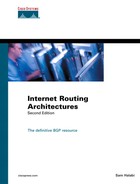Transitioning the Regional Networks from the NSFNET
As part of the NSFNET solicitation for transitioning to the new Internet architecture, NSF requested that the regional networks (also called mid-level networks) start transitioning their connections from the NSFNET backbones to other providers.
Regional networks have been a part of the NSFNET since its creation and have played a major role in the network connectivity of the research and education community. Regional network providers (RNPs) connect a broad base of client/member organizations (such as universities), providing them with multiple networking services and with Inter-Regional Connectivity (IRC).
Here are the anticipated duties of the RNPs per the NSF 93-52 program solicitation:
-
Provide for interregional connectivity by such means as connecting to NSPs that are connected to NAPs and/or by connecting to NAPs directly and making inter-NAP connectivity arrangements with one or more NSPs.
-
Provide for innovative network information services for client/member organizations in cooperation with the InterNIC and the NSFNET Information Services Manager.
-
Propose and establish procedures to work with personnel from the NAP manager(s), the RA, the vBNS provider, and other regional and attached networks to resolve problems and to support end-to-end connectivity and quality of service for network users.
-
Provide services that promote broadening the base of network users within the research and communications community.
-
Provide for (possibly in cooperation with an NSP) high-bandwidth connections for client/member institutions that have meritorious high-bandwidth applications.
-
Provide for network connections to client/member organizations.
In the process of moving the regional networks from the NSFNET to the new ISP connections, the NSF suggested that they be connected either directly to the NAPs or to providers connected to the NAPs. During the transition, NSF supported, for one year, connection fees that would decrease and eventually cease (after the first term of the NAP Manager/RA Cooperative Agreement, which shall be no more than four years).
Table 1-1 lists some of the old NSFNET regional providers and their new respective regional providers under the current Internet environment. As you can see, most of the regional providers have shifted to either MCInet (now Cable & Wireless) or Sprintlink. Moving the regional providers to the new Internet architecture in time for the April 1995 deadline was one of the major milestones that NSFNET had to achieve.
| Old Regional Network | New Internet Provider |
|---|---|
| Argone | CICnet |
| BARRnet | MCInet |
| CA*net | MCInet |
| CERFnet | CERFnet |
| CICnet | MCInet |
| Cornell Theory Center | MCInet |
| CSUnet | MCInet |
| DARPA | ANSnet |
| JvNCnet | MCInet |
| MOREnet | Sprintlink |
| NEARnet | MCInet |
| NevadaNet | Sprintlink |
| SESQUINET | MCInet |
| SURAnet | MCInet |
| THEnet | MCInet |
| Westnet | Sprintlink |
